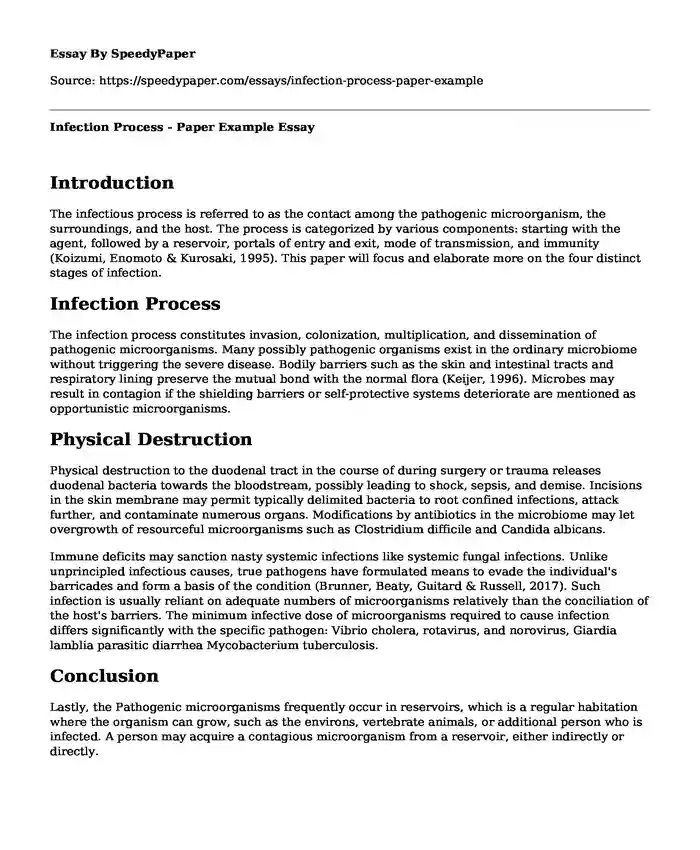
| Type of paper: | Essay |
| Categories: | Medicine |
| Pages: | 2 |
| Wordcount: | 408 words |
Introduction
The infectious process is referred to as the contact among the pathogenic microorganism, the surroundings, and the host. The process is categorized by various components: starting with the agent, followed by a reservoir, portals of entry and exit, mode of transmission, and immunity (Koizumi, Enomoto & Kurosaki, 1995). This paper will focus and elaborate more on the four distinct stages of infection.
Infection Process
The infection process constitutes invasion, colonization, multiplication, and dissemination of pathogenic microorganisms. Many possibly pathogenic organisms exist in the ordinary microbiome without triggering the severe disease. Bodily barriers such as the skin and intestinal tracts and respiratory lining preserve the mutual bond with the normal flora (Keijer, 1996). Microbes may result in contagion if the shielding barriers or self-protective systems deteriorate are mentioned as opportunistic microorganisms.
Physical Destruction
Physical destruction to the duodenal tract in the course of during surgery or trauma releases duodenal bacteria towards the bloodstream, possibly leading to shock, sepsis, and demise. Incisions in the skin membrane may permit typically delimited bacteria to root confined infections, attack further, and contaminate numerous organs. Modifications by antibiotics in the microbiome may let overgrowth of resourceful microorganisms such as Clostridium difficile and Candida albicans.
Immune deficits may sanction nasty systemic infections like systemic fungal infections. Unlike unprincipled infectious causes, true pathogens have formulated means to evade the individual's barricades and form a basis of the condition (Brunner, Beaty, Guitard & Russell, 2017). Such infection is usually reliant on adequate numbers of microorganisms relatively than the conciliation of the host's barriers. The minimum infective dose of microorganisms required to cause infection differs significantly with the specific pathogen: Vibrio cholera, rotavirus, and norovirus, Giardia lamblia parasitic diarrhea Mycobacterium tuberculosis.
Conclusion
Lastly, the Pathogenic microorganisms frequently occur in reservoirs, which is a regular habitation where the organism can grow, such as the environs, vertebrate animals, or additional person who is infected. A person may acquire a contagious microorganism from a reservoir, either indirectly or directly.
Reference
Brunner, J. L., Beaty, L., Guitard, A., & Russell, D. (2017). Heterogeneities in the infection process drive ranavirus transmission. Ecology, 98(2), 576-582.
Keijer, J. (1996). The initial steps of the infection process in Rhizoctonia solani. In Rhizoctonia species: Taxonomy, molecular biology, ecology, pathology and disease control (pp. 149-162). Springer, Dordrecht.
Koizumi, K., Enomoto, N., Kurosaki, M., Murakami, T., Izumi, N., Marumo, F., & Sato, C. (1995). Diversity of quasispecies in various disease stages of chronic hepatitis C virus infection and its significance in interferon treatment. Hepatology, 22(1), 30-35.
Cite this page
Infection Process - Paper Example. (2023, Dec 25). Retrieved from https://speedypaper.com/essays/infection-process-paper-example
Request Removal
If you are the original author of this essay and no longer wish to have it published on the SpeedyPaper website, please click below to request its removal:
- Free Essay: Informed Practitioner Who Provides Trauma Informed Care
- Free Essay Sample about Historical Epidemics
- Essay Example Dedicated to HIV Prophylaxis Following Occupational Exposure
- Free Essay Comprising Patient Interview and Establishing a Diagnosis
- Free Essay: Fat-soluble and Water-soluble Vitamins
- Paper Example on Pseudomonas Alkanolytica Using in Treatment
- The Effects of Parental Education in the Health and Nutrition of African American Children - Essay Sample
Popular categories




